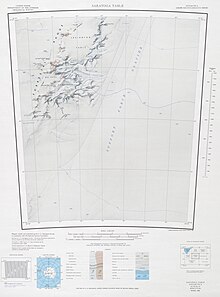|
Forrestal Range
Mountain range in the Pensacola Mountains of Antarctica
Forrestal Range in Antarctica The Forrestal Range (83°00′S 049°30′W / 83.000°S 49.500°W / -83.000; -49.500 (Forrestal Range)) is a largely snow-covered mountain range, about 65 nautical miles (120 km; 75 mi) long, standing east of Dufek Massif and the Neptune Range in the Pensacola Mountains, Antarctica.
Discovery and name
The Forrestal Range was discovered and photographed on 13 January 1956 on a transcontinental patrol plane flight of United States Navy Operation Deep Freeze I from McMurdo Sound to the vicinity of the Weddell Sea and return.
It was named by the United States Advisory Committee on Antarctic Names (US-ACAN) after USS Forrestal, first supercarrier of the U.S. Navy.
The entire Pensacola Mountains were mapped by United States Geological Survey (USGS) in 1967 and 1968 from United States Navy tricamera aerial photographs taken in 1964.
Location
![]() Northern Forrestal Range in center, south of map Northern Forrestal Range in center, south of map
 South part of Forrestal Range in northwest of map South part of Forrestal Range in northwest of map
The Forrestal Range extends in a north-northeast direction along the west side of the Support Force Glacier. The Median Snowfield is to its south and the Sallee Snowfield to its west, separating it from the Dufek Massif. The Ford Ice Piedmont is to its north.
Major features from south to north include the Saratoga Table, Lexington Table, Kester Peaks and Mount Malville.
Major glaciers and snowfields
Peaks
Peaks over 1,500 metres (4,900 ft) high include:
| Mountain |
m |
ft |
coord
|
| Burmester Dome |
2,095 |
6,873 |
83°22′S 50°56′W / 83.367°S 50.933°W / -83.367; -50.933 (Burmester Dome)
|
| Mount Stephens |
2,065 |
6,775 |
83°23′S 51°27′W / 83.383°S 51.450°W / -83.383; -51.450 (Mount Stephens)
|
| Mount Lechner |
2,030 |
6,660 |
83°14′S 50°55′W / 83.233°S 50.917°W / -83.233; -50.917 (Mount Lechner)
|
| Fierle Peak |
1,960 |
6,430 |
83°25′S 50°58′W / 83.417°S 50.967°W / -83.417; -50.967 (Fierle Peak)
|
| Dyrdal Peak |
1,820 |
5,971 |
83°25′S 51°23′W / 83.417°S 51.383°W / -83.417; -51.383 (Dyrdal Peak)
|
| Watts Summit |
1,785 |
5,856 |
83°12′S 50°31′W / 83.200°S 50.517°W / -83.200; -50.517 (Watts Summit)
|
| Vigen Cliffs |
1,750 |
5,741 |
83°23′S 50°07′W / 83.383°S 50.117°W / -83.383; -50.117 (Vigen Cliffs)
|
| Gabbro Crest |
1,750 |
5,741 |
83°28′S 50°22′W / 83.467°S 50.367°W / -83.467; -50.367 (Gabbro Crest)
|
| Sheriff Cliffs |
1,750 |
5,741 |
83°24′S 50°37′W / 83.400°S 50.617°W / -83.400; -50.617 (Sheriff Cliffs)
|
| Haskill Nunatak |
1,710 |
5,610 |
83°24′S 51°45′W / 83.400°S 51.750°W / -83.400; -51.750 (Haskill Nunatak)
|
| Mount Mann |
1,680 |
5,512 |
83°12′S 49°20′W / 83.200°S 49.333°W / -83.200; -49.333 (Mount Mann)
|
| Henderson Bluff |
1,660 |
5,446 |
83°05′S 50°35′W / 83.083°S 50.583°W / -83.083; -50.583 (Henderson Bluff)
|
| Ray Nunatak |
1,630 |
5,348 |
83°28′S 51°58′W / 83.467°S 51.967°W / -83.467; -51.967 (Ray Nunatak)
|
| Blount Nunatak |
1,630 |
5,348 |
83°16′S 51°19′W / 83.267°S 51.317°W / -83.267; -51.317 (Blount Nunatak)
|
| Beiszer Nunatak |
1,630 |
5,348 |
83°29′S 51°57′W / 83.483°S 51.950°W / -83.483; -51.950 (Beiszer Nunatak)
|
| Mount Zirzow |
1,615 |
5,299 |
83°08′S 49°06′W / 83.133°S 49.100°W / -83.133; -49.100 (Mount Zirzow)
|
Feature groupings
Features that are the focus of a group of lesser or related features include
- Mount Malville (82°44′S 48°10′W / 82.733°S 48.167°W / -82.733; -48.167 (Mount Malville)), a mountain, 1,030 metres (3,380 ft) high, standing 5 nautical miles (9.3 km; 5.8 mi) southwest of Ackerman Nunatak in the northern part of the Forrestal Range.
- Kester Peaks (82°49′S 48°23′W / 82.817°S 48.383°W / -82.817; -48.383 (Kester Peaks)) are three aligned rock peaks standing together 5 nautical miles (9.3 km; 5.8 mi) south of Mount Malville on the east side of the Forrestal Range.
- Lexington Table (83°05′S 49°45′W / 83.083°S 49.750°W / -83.083; -49.750 (Lexington Table)), a high, flat, snow-covered plateau, about 15 nautical miles (28 km; 17 mi) long and 10 nautical miles (19 km; 12 mi) wide, standing just north of Kent Gap and Saratoga Table.
- Saratoga Table (83°20′S 50°30′W / 83.333°S 50.500°W / -83.333; -50.500 (Saratoga Table)) , a high, flat, snow-covered plateau, 8 nautical miles (15 km; 9.2 mi) long and 6 nautical miles (11 km; 6.9 mi) wide, standing just south of Kent Gap and Lexington Table in the southern Forrestal Range.
References
Sources
|
|